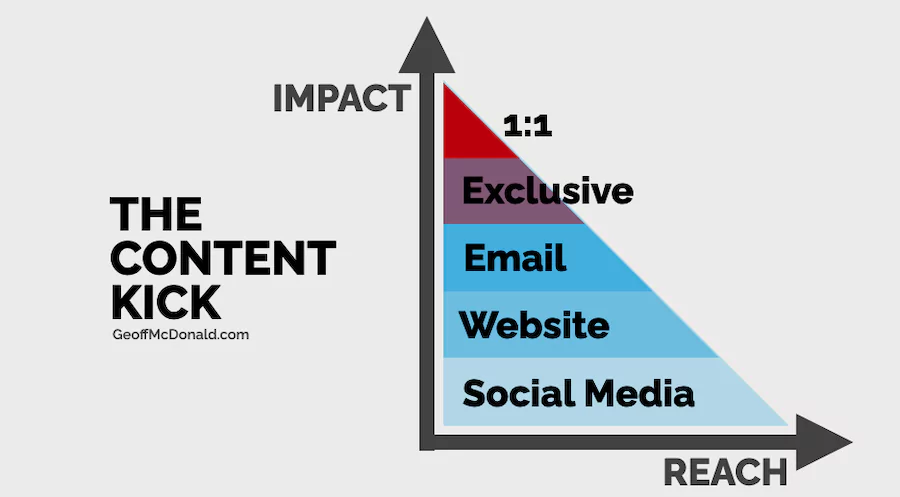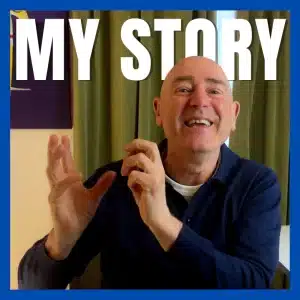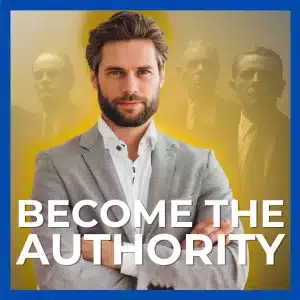Thought Leaders earn money from their ideas. This means the most important part of your business is to create and share your IP and content to attract and keep clients.
 But for thought leaders, Content Creation means both IP creation and Content Marketing.
The Content Creation Canvas is unique because it unites these two types of content into a single strategic template.
In this post, I’ll ask you the seven questions you need to answer to have a clear content creation strategy.
But for thought leaders, Content Creation means both IP creation and Content Marketing.
The Content Creation Canvas is unique because it unites these two types of content into a single strategic template.
In this post, I’ll ask you the seven questions you need to answer to have a clear content creation strategy.

 In Thought Leadership Strategy, I pointed to three types of capital that every thought leader needs to build:
In Thought Leadership Strategy, I pointed to three types of capital that every thought leader needs to build:
 In Scrum or Agile software development they use a simple three-part product story formula to tune into what their clients want. You can use this to create your content and to tune into what your clients want – your Client Content Story.
The formula is: As an X, I want to Y so I can Z.
In Scrum or Agile software development they use a simple three-part product story formula to tune into what their clients want. You can use this to create your content and to tune into what your clients want – your Client Content Story.
The formula is: As an X, I want to Y so I can Z.
 In Joseph Campbell’s Heroes Journey, he talked about this as the Ordinary World and the Special World. It’s the shift from now with your current problem to your future where the problem is resolved and transformed.
For more, consider the post: The most important thought leadership skills to develop.
In Joseph Campbell’s Heroes Journey, he talked about this as the Ordinary World and the Special World. It’s the shift from now with your current problem to your future where the problem is resolved and transformed.
For more, consider the post: The most important thought leadership skills to develop.
 By definition, a manifesto is a declaration of your intention. It’s what you want to have happen.
On the Content Creation Canvas, it’s your solution.
Ideally, it has three parts:
By definition, a manifesto is a declaration of your intention. It’s what you want to have happen.
On the Content Creation Canvas, it’s your solution.
Ideally, it has three parts:
 And this is a great flaw for most around content creation and in particular their content marketing. They create one set of content to attract clients and another to keep them.
That’s twice the work – no thanks.
However, there is an easy solution – Merge the two.
I’ve called this Capital Content because it is your top content, your primary content and your most important content. It’s one set of content that attracts new clients AND keeps your existing clients.
You can find out more about this in the post, Capital Content: A Daring Content Creation Idea to Double Your Results.
And this is a great flaw for most around content creation and in particular their content marketing. They create one set of content to attract clients and another to keep them.
That’s twice the work – no thanks.
However, there is an easy solution – Merge the two.
I’ve called this Capital Content because it is your top content, your primary content and your most important content. It’s one set of content that attracts new clients AND keeps your existing clients.
You can find out more about this in the post, Capital Content: A Daring Content Creation Idea to Double Your Results.
The Content Kick and Your Signature Style
The Content Kick suggests having personalised and exclusive content for your clients is more valuable because it’s cheaper to keep an existing client than attract a new one.
You also want to pair this with your Signature Style. Most people don’t stand out because they’re doing the same thing in the same way as everybody else. That’s not going to work.
To define the output you will create, determine:
 I used to be an architect. And the way architects work is that they design the whole building right down to the details of where the nuts and bolts go. Once the building is designed, they then hand it over to the builder.
As you might expect with this background, I’m really really good at making great plans. But I’ve also had my share of struggles at finishing things.
I wrote about this in my book, Done. Having a great plan is a great start. But most plans only tell you what to do. They don’t tell you how to do it.
I used to be an architect. And the way architects work is that they design the whole building right down to the details of where the nuts and bolts go. Once the building is designed, they then hand it over to the builder.
As you might expect with this background, I’m really really good at making great plans. But I’ve also had my share of struggles at finishing things.
I wrote about this in my book, Done. Having a great plan is a great start. But most plans only tell you what to do. They don’t tell you how to do it.

- But what IP and content should you create?
- How should you create it?
- And where should you share and publish it?
What is Content Creation?
Most people when they talk about Content Creation are referring to Content Marketing. But for thought leaders, Content Creation means both IP creation and Content Marketing.
The Content Creation Canvas is unique because it unites these two types of content into a single strategic template.
In this post, I’ll ask you the seven questions you need to answer to have a clear content creation strategy.
But for thought leaders, Content Creation means both IP creation and Content Marketing.
The Content Creation Canvas is unique because it unites these two types of content into a single strategic template.
In this post, I’ll ask you the seven questions you need to answer to have a clear content creation strategy.
The Four Content Creation Strategies
The Content Creation Canvas is composed of seven elements which are neatly arranged into four groups. Three of these are pairs and the third is a solo element.- Objectives – The first pair of elements on the Content Creation Canvas define our objectives. We want to top and tail our strategy with the key questions: what do we want and what does our audience want.
- Thought Leadership – The second pair of elements on the Content Creation Canvas define our thought leadership view of the world. These are your Content Pillars – where you focus on the shift your clients will make when they work with you.
- The Pivot – Next is the translation or pivot point from our big picture thought leadership ideals to the specific elements that will help us both attract and keep our clients. It’s your Capital Content that is central to the whole strategy.
- Practical Action – Finally, we have the pair of elements on the Content Creation Canvas that defines the specific actions you are going to take. It’s your behaviour and the output that results from that behaviour.
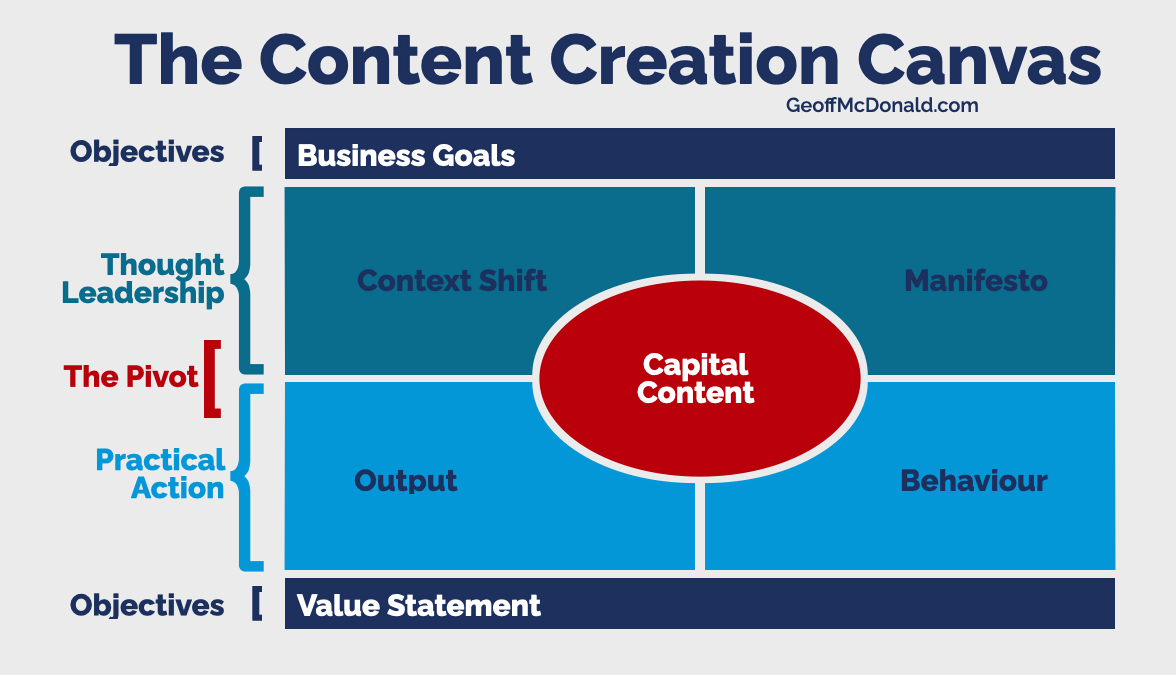
1 What do you want?
“Would you tell me, please, which way I ought to go from here?” “That depends a good deal on where you want to get to,” said the Cat. “I don’t much care where—” said Alice. “Then it doesn’t matter which way you go,” said the Cat. Lewis Carroll, Alice in WonderlandThe Content Creation Canvas is a strategy template. But before you can do any strategy work you have to work out where you are going – it’s what before how.
The Three Thought Leadership Goals
 In Thought Leadership Strategy, I pointed to three types of capital that every thought leader needs to build:
In Thought Leadership Strategy, I pointed to three types of capital that every thought leader needs to build:
- Money or financial capital
- Ideas or intellectual capital
- People or social capital
Your Hyperfocus
But, rather than having three different things to focus on, being able to combine them into a single hyperfocus is where you will gain the greatest results from your efforts. For more on this step, read the post, Thought Leadership Strategy.2 What do your clients want?
The big mistake
Many beginners and seasoned business experts fall for the same mistake in their marketing and business growth strategies. They focus on what they have to offer and not on what their clients want. This means they either try to sell something their clients don’t want or they sell it in a way that their clients can’t hear. This is one reason that so many people create so much content that doesn’t produce any results. They get lost in the crowd.The Scrum Product Story Formula
 In Scrum or Agile software development they use a simple three-part product story formula to tune into what their clients want. You can use this to create your content and to tune into what your clients want – your Client Content Story.
The formula is: As an X, I want to Y so I can Z.
In Scrum or Agile software development they use a simple three-part product story formula to tune into what their clients want. You can use this to create your content and to tune into what your clients want – your Client Content Story.
The formula is: As an X, I want to Y so I can Z.
- ‘As an X’ defines who the end-user or client is.
- ‘I want to Y’ tell us what the client wants to achieve.
- And ‘so I can Z’ tells us why the client wants this – their motivation.
3 What is the Context?
What’s the most important skill a thought leader should develop? Thought leaders earn money from their ideas. The purpose of ideas is to generate new and more effective action. There are two levels at which we do this.- The actual moves or actions we take (Climbing a ladder)
- The context that tells us what moves to make (It tells us which wall we need to put our ladder up against.)
- What is the current context we are operating from? It’s your label for your client’s current situation with their current problem.
- What is a better context to operate from? This is your label for the client’s future situation with the problem resolved.
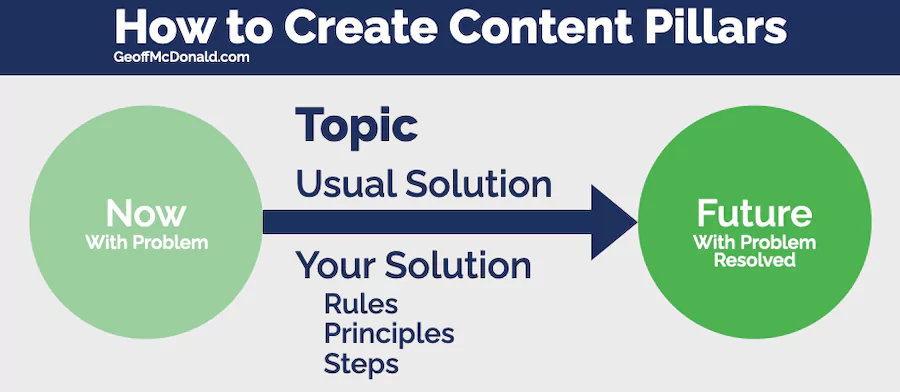 In Joseph Campbell’s Heroes Journey, he talked about this as the Ordinary World and the Special World. It’s the shift from now with your current problem to your future where the problem is resolved and transformed.
For more, consider the post: The most important thought leadership skills to develop.
In Joseph Campbell’s Heroes Journey, he talked about this as the Ordinary World and the Special World. It’s the shift from now with your current problem to your future where the problem is resolved and transformed.
For more, consider the post: The most important thought leadership skills to develop.
4 What is your solution?
What does the word ‘manifesto’ make you think about?- You might think of Marx and Engel who wrote The Communist Manifesto.
- Or perhaps a person who wants to change the world.
- In some parts of the world, it might mean an election is coming. Politicians declare their election promises as a manifesto.
- In the art world, it usually means a revolution.
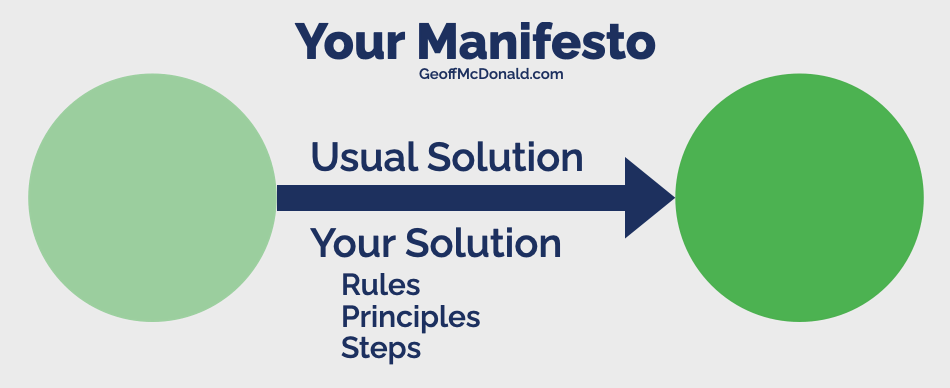 By definition, a manifesto is a declaration of your intention. It’s what you want to have happen.
On the Content Creation Canvas, it’s your solution.
Ideally, it has three parts:
By definition, a manifesto is a declaration of your intention. It’s what you want to have happen.
On the Content Creation Canvas, it’s your solution.
Ideally, it has three parts:
- Some reference to the usual way people solve the current problem – and why that is not enough.
- A description of the world as you’d like it to be – when the problem is solved
- A set of rules, principles or steps for getting there.
5 How can you attract and keep clients?
Most marketers focus on the wrong thing. They focus on attracting new clients when it is 5-25 times cheaper to keep an existing one. This is even worse for solo operators. They’re either busy promoting themselves to gain new clients or they’re busy serving their existing ones. This means they are caught up in the boom-and-bust cycle of business bouncing from flood to drought and back again.- I have plenty of work, so I don’t promote myself.
- I have no work, so I promote myself heavily.
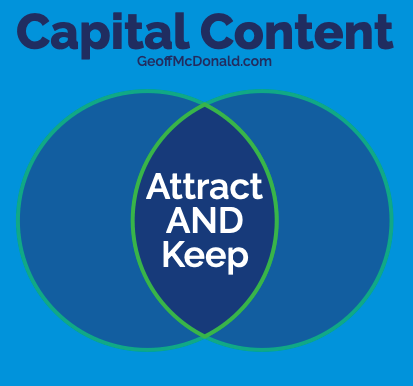 And this is a great flaw for most around content creation and in particular their content marketing. They create one set of content to attract clients and another to keep them.
That’s twice the work – no thanks.
However, there is an easy solution – Merge the two.
I’ve called this Capital Content because it is your top content, your primary content and your most important content. It’s one set of content that attracts new clients AND keeps your existing clients.
You can find out more about this in the post, Capital Content: A Daring Content Creation Idea to Double Your Results.
And this is a great flaw for most around content creation and in particular their content marketing. They create one set of content to attract clients and another to keep them.
That’s twice the work – no thanks.
However, there is an easy solution – Merge the two.
I’ve called this Capital Content because it is your top content, your primary content and your most important content. It’s one set of content that attracts new clients AND keeps your existing clients.
You can find out more about this in the post, Capital Content: A Daring Content Creation Idea to Double Your Results.
6 What will be your output?
When you build a house you always start with the foundation and build from the ground up. The roof always goes on last. But most people do something strange with their content creation. It seems like they want to start with the roof. We’re now at step 6 of seven steps, but this is where most people start. They want to know if they should be on LinkedIn, Facebook, YouTube, TikTok. They think if they answer that question, it will solve everything else. But I think all this achieves is that it puts you in direct competition with everybody else who’s out there screaming and yelling for attention. It’s like being at a party or a rock concert, where everyone is yelling and screaming for attention over all the noise in the background. Is it any wonder they don’t get the results they want? I think there is a better way.The Content Kick and Your Signature Style
The Content Kick suggests having personalised and exclusive content for your clients is more valuable because it’s cheaper to keep an existing client than attract a new one.
You also want to pair this with your Signature Style. Most people don’t stand out because they’re doing the same thing in the same way as everybody else. That’s not going to work.
To define the output you will create, determine:
- What you will create,
- How you will create it, and
- Where you will share it
Output not Results
You might have noticed that the focus here is on output, not results. For instance, produce one YouTube video a week and not attract 10,000 views per week. Yes, you want your content to produce results. We all want a reward for our efforts. One of the great shifts in sports psychology (and one of the great cliches in media interviews) is to hear a sportsperson say ‘We are just focusing on what we can control’. In other words, we’re focusing on our output because we cannot control our results. This is especially true of social media and content marketing. We cannot control all of the forces that shape whether one post takes off and another doesn’t. Also, this is one of the keys to why The Content Kick is a powerful strategy – it’s a more focused, more direct approach that gives you more control over your content.7 What behaviours will create this?
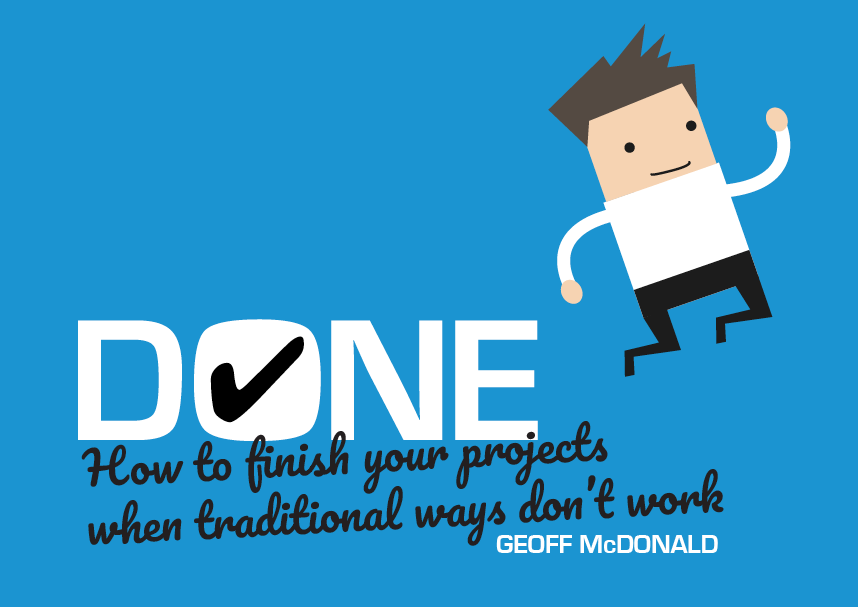 I used to be an architect. And the way architects work is that they design the whole building right down to the details of where the nuts and bolts go. Once the building is designed, they then hand it over to the builder.
As you might expect with this background, I’m really really good at making great plans. But I’ve also had my share of struggles at finishing things.
I wrote about this in my book, Done. Having a great plan is a great start. But most plans only tell you what to do. They don’t tell you how to do it.
I used to be an architect. And the way architects work is that they design the whole building right down to the details of where the nuts and bolts go. Once the building is designed, they then hand it over to the builder.
As you might expect with this background, I’m really really good at making great plans. But I’ve also had my share of struggles at finishing things.
I wrote about this in my book, Done. Having a great plan is a great start. But most plans only tell you what to do. They don’t tell you how to do it.
Writing a Book
For instance, if you’re writing a book and your plan might say ‘write two hours every day’. But how are you going to do that?- How are you going to find two hours a day?
- Where will you write?
- How will you stay motivated?
Summary: The Content Creation Canvas
Let’s wrap up what we’ve covered here…- The Content Creation Canvas helps you define your thought leadership content strategy.
- Content Creation includes both IP creation and Content Marketing.
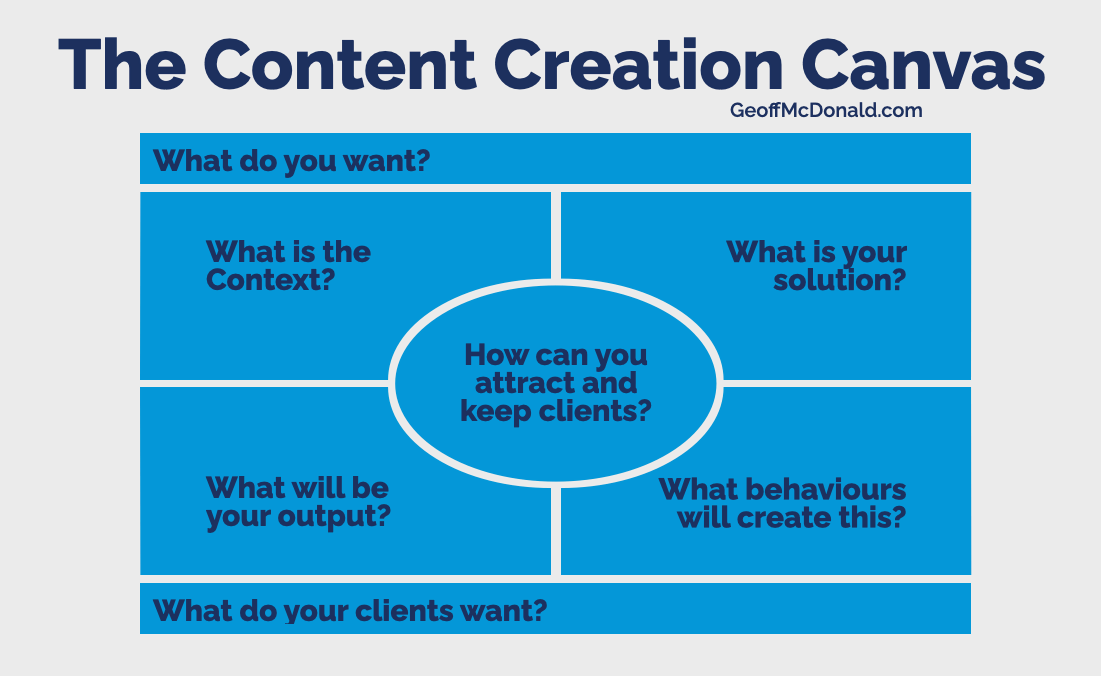
More: The Seven Questions
Each of the seven strategic questions has a companion video/post you can watch/read for more details. Here are those links:- What do you want?
- What do your clients want?
- What is the Context?
- What is your solution?
- How can you attract and keep clients?
- What will be your output?
- What behaviours will create this? (coming soon)
Add a Comment
Which of the seven Content Creation Canvas questions stands out for you?Templates
Click the buttons below to download your free templates – start now – no email or opt-in required.

